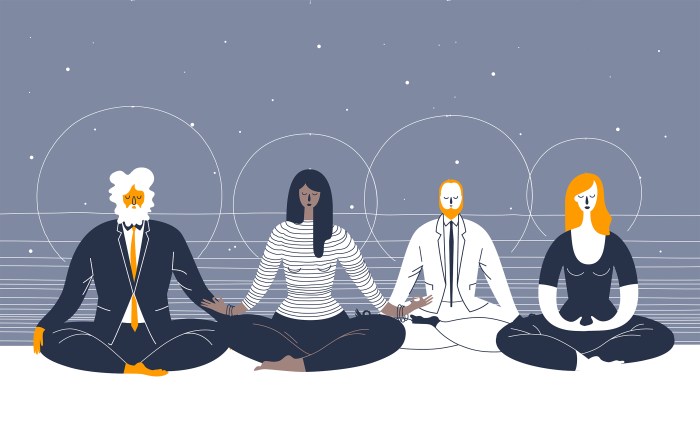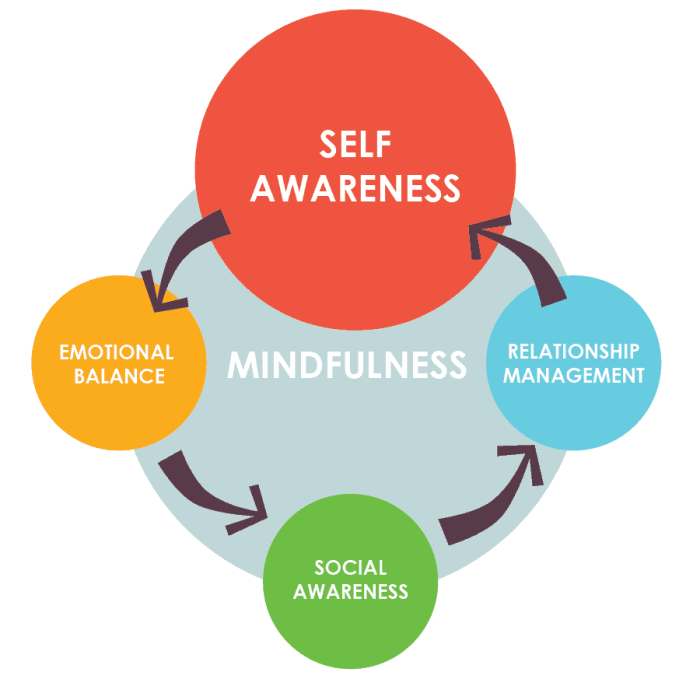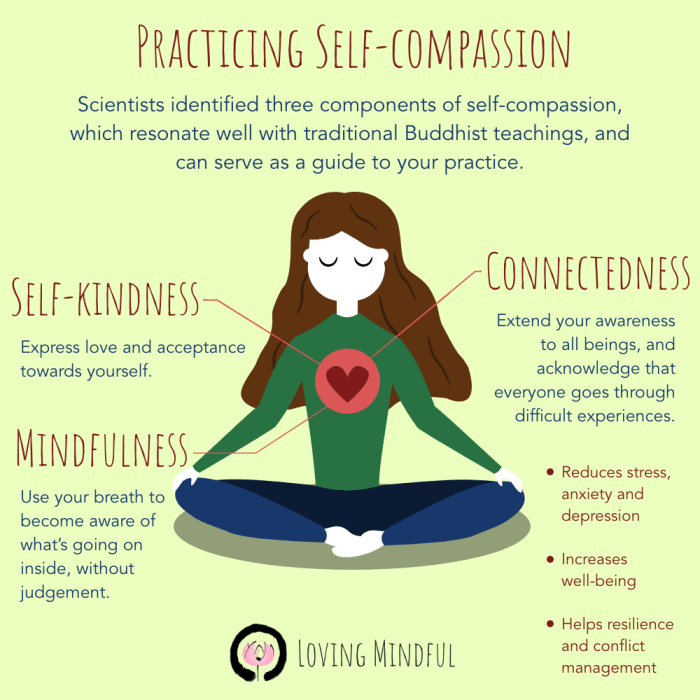Delving into 20 Ways to Cultivate Mindfulness Through Meditation, this introduction immerses readers in a unique and compelling narrative, with elegant Maluku style that is both engaging and thought-provoking from the very first sentence.
Embark on a journey of self-discovery and inner peace as we explore the transformative power of mindfulness through meditation practices.
Introduction to Mindfulness Meditation
Mindfulness meditation is a practice that involves focusing your mind on the present moment without judgment. It allows you to cultivate a sense of awareness and acceptance of your thoughts, emotions, and sensations.
By practicing mindfulness meditation, you can experience a range of benefits, including reduced stress, improved concentration, enhanced emotional well-being, and increased self-awareness.
Principles of Mindfulness Meditation
- Focus on the present moment: Mindfulness meditation encourages you to direct your attention to what is happening right now, rather than dwelling on the past or worrying about the future.
- Non-judgmental awareness: Instead of labeling your thoughts and feelings as “good” or “bad,” mindfulness meditation teaches you to observe them without attachment or criticism.
- Cultivating compassion: Through mindfulness meditation, you can develop a sense of empathy and kindness towards yourself and others, fostering a deeper connection with the world around you.
History and Origins of Mindfulness Meditation
Mindfulness meditation has roots in ancient Buddhist traditions, particularly in the practice of Vipassana, which means “insight” or “clear seeing.” This form of meditation has been passed down through generations and adapted for modern contexts, becoming a widely practiced technique for mental well-being.
Setting Up Your Meditation Space: 20 Ways To Cultivate Mindfulness Through Meditation
Creating a peaceful meditation space at home is essential for cultivating mindfulness through meditation. Your environment can greatly influence the quality of your practice, so here are some tips on setting up your meditation space:
Choosing Suitable Meditation Accessories
When choosing accessories for your meditation space, opt for items that promote a sense of calm and tranquility. Consider incorporating elements such as:
- A comfortable meditation cushion or mat to support your posture and provide cushioning.
- Candles, incense, or essential oils to create a calming atmosphere and engage your senses.
- Inspirational artwork or plants to bring beauty and positivity to your space.
Importance of a Comfortable Seating Arrangement
Your seating arrangement plays a crucial role in maintaining comfort and focus during meditation. Here are some tips for creating a comfortable seating arrangement:
- Choose a chair, cushion, or bench that supports your spine and allows you to sit upright without strain.
- Ensure that your feet are firmly planted on the ground to promote stability and grounding.
- Experiment with different seating options to find what works best for you and allows you to maintain a relaxed yet alert posture.
Breathing Techniques for Mindfulness

Breathing is a fundamental aspect of mindfulness meditation, as it serves as an anchor to keep the mind focused and present. By paying attention to the breath, we can cultivate a sense of calm and awareness in the present moment.
Diaphragmatic Breathing
One of the most common breathing techniques in mindfulness meditation is diaphragmatic breathing, also known as deep belly breathing. This involves breathing deeply into the belly, allowing the diaphragm to expand and contract fully.
Focus on the sensation of the breath entering and leaving the body, feeling the rise and fall of the abdomen with each inhale and exhale.
Counted Breathing
Another effective technique is counted breathing, where you count the duration of each inhale and exhale. This helps regulate the breath and maintain a steady rhythm, promoting relaxation and mindfulness.
Start by inhaling for a count of four, holding for two, and exhaling for a count of six, gradually increasing the count as you become more comfortable.
Box Breathing
Box breathing is a technique that involves equalizing the length of each inhale, hold, exhale, and hold, creating a square or “box” pattern with the breath. This practice can help calm the mind and enhance focus.
Inhale for a count of four, hold for four, exhale for four, and hold for four before beginning the cycle again.
Types of Mindfulness Meditation Practices

Mindfulness meditation can take many forms, each with its unique focus and benefits. Exploring various types of mindfulness meditation practices can help individuals find the right technique that resonates with them. Let’s compare and contrast different meditation techniques for mindfulness and provide guidance on choosing the right practice for individual preferences.
Body Scan Meditation
In body scan meditation, practitioners focus on each part of their body, starting from the toes and moving up to the head. This practice helps in increasing body awareness, releasing tension, and promoting relaxation.
Loving-Kindness Meditation
Loving-kindness meditation involves sending well-wishes and compassion to oneself and others. This practice cultivates feelings of love, empathy, and kindness, fostering a sense of connection and positivity.
Walking Meditation
Walking meditation combines mindfulness with walking, allowing practitioners to focus on each step, the sensations in the body, and the surroundings. This practice can enhance awareness, grounding, and concentration.
Overcoming Common Challenges

During mindfulness meditation, practitioners often face common challenges that can hinder their practice. It is important to acknowledge these obstacles and develop strategies to overcome them in order to cultivate a deeper sense of mindfulness.
Dealing with Distractions
Distractions are a common challenge during meditation, as the mind tends to wander and thoughts can easily pull focus away from the present moment. To overcome distractions, practitioners can:
- Acknowledge the distraction without judgment and gently guide the focus back to the breath or anchor point.
- Label the distraction as “thinking” and return to the present moment without getting caught up in the thought.
- Practice self-compassion and patience, understanding that distractions are a natural part of the meditation process.
Handling Discomfort or Restlessness
Feelings of discomfort or restlessness can arise during meditation, making it challenging to sit still and remain present. To address these sensations, practitioners can:
- Shift positions slightly or make small adjustments to increase comfort without disrupting the practice.
- Bring attention to the physical sensations and observe them with curiosity and acceptance, rather than trying to resist or avoid them.
- Focus on the breath or body sensations to anchor the mind and create a sense of grounding amidst discomfort.
Incorporating Mindfulness in Daily Life
Integrating mindfulness practices into daily routines can significantly enhance your overall well-being and quality of life. By being fully present in the moment, you can cultivate a deep sense of awareness and connection with yourself and the world around you.
Mindful Eating
One way to incorporate mindfulness into your daily life is through mindful eating. Take the time to savor each bite, paying attention to the flavors, textures, and sensations in your mouth. Avoid distractions such as watching TV or scrolling through your phone while eating. By focusing on your meal, you can develop a healthier relationship with food and improve digestion.
Mindful Walking
Another way to practice mindfulness in your daily routine is through mindful walking. Whether you’re walking to work or simply taking a stroll in the park, pay attention to each step you take. Feel the ground beneath your feet, the movement of your body, and the rhythm of your breath. Walking mindfully can help reduce stress, improve concentration, and enhance your overall sense of well-being.
Benefits of Carrying Mindfulness Beyond Meditation
Extending mindfulness beyond your meditation sessions can have numerous benefits in your daily life. By cultivating a present-moment awareness in all your activities, you can reduce stress, enhance focus, improve relationships, and increase overall happiness. Mindfulness can help you respond to challenges with clarity and compassion, leading to a more balanced and fulfilling life.
Mindful Listening and Communication

Mindful listening and communication play a crucial role in building strong relationships and fostering understanding between individuals. By practicing mindfulness in our interactions, we can improve our listening skills, enhance empathy, and communicate more effectively.
Techniques to Improve Listening Skills through Mindfulness
- Practice active listening: Focus on the speaker without interrupting or formulating responses in your mind.
- Stay present in the moment: Avoid distractions and truly engage with the speaker’s words.
- Observe non-verbal cues: Pay attention to body language and tone to better understand the speaker’s emotions.
- Cultivate curiosity: Approach conversations with an open mind and a genuine interest in what the other person has to say.
How Mindfulness Enhances Empathy and Understanding in Communication
- Increases emotional intelligence: Mindfulness helps us recognize and regulate our emotions, leading to more empathetic responses.
- Promotes active listening: By being fully present in conversations, we can better understand others’ perspectives and respond with empathy.
- Fosters compassion: Mindfulness cultivates a sense of compassion towards others, allowing for more empathetic and understanding communication.
Mindfulness Meditation for Stress Reduction
Mindfulness meditation is a powerful tool for reducing stress by helping individuals cultivate a sense of calm and presence in the midst of challenging situations.
Mindfulness Techniques for Stress Relief, 20 Ways to Cultivate Mindfulness Through Meditation
- Body Scan: Start by focusing on different parts of your body, noticing any tension or discomfort, and then releasing it with each breath.
- Loving-Kindness Meditation: Practice sending love and compassion to yourself and others, promoting feelings of connection and empathy.
- Visualization: Imagine a peaceful place or scenario that brings you joy and relaxation, allowing your mind to escape from stressors.
- Walking Meditation: Take a slow, mindful walk, paying attention to each step and the sensations in your body, grounding yourself in the present moment.
Real-Life Examples of Stress Management through Mindfulness
“After incorporating mindfulness meditation into my daily routine, I noticed a significant decrease in my stress levels. I was able to approach challenges with a sense of clarity and calmness, rather than feeling overwhelmed.”
“By practicing mindfulness techniques like deep breathing and body scans, I learned to manage my stress in a healthier way. I no longer let anxiety control my thoughts and actions, allowing me to live more freely and joyfully.”
Mindfulness Meditation for Emotional Regulation
Mindfulness meditation plays a crucial role in helping individuals manage their emotions more effectively. By cultivating awareness of our thoughts and feelings in the present moment without judgment, we can develop greater emotional regulation skills.
Practices for Emotional Regulation
- Body Scan Meditation: This practice involves bringing attention to different parts of the body, noticing any physical sensations or tension. By observing and accepting these sensations without reacting, we can learn to regulate our emotional responses.
- Loving-Kindness Meditation: By directing feelings of love and compassion towards ourselves and others, we can cultivate empathy and understanding, leading to healthier emotional regulation.
- R.A.I.N Technique: Recognize, Accept, Investigate, and Non-Identification. This method helps individuals acknowledge and explore their emotions without getting overwhelmed, promoting a more balanced emotional state.
Enhancing Emotional Intelligence through Mindfulness
- Increased Self-Awareness: Mindfulness meditation helps individuals become more in tune with their emotions, allowing them to recognize and understand their feelings better.
- Improved Self-Regulation: By practicing mindfulness, individuals can develop the ability to regulate their emotional responses, leading to more thoughtful and intentional reactions.
- Enhanced Empathy: Mindfulness fosters compassion towards oneself and others, promoting empathy and deeper emotional connections.
Mindfulness Meditation and Improved Focus
Mindfulness meditation has been shown to have a profound impact on improving focus and concentration. By training the mind to be present in the moment without judgment, individuals can enhance their ability to pay attention to the task at hand.
Techniques to Enhance Concentration Through Mindfulness
- Focus on your breath: By anchoring your attention to the sensations of your breath, you can train your mind to stay focused on the present moment.
- Body scan meditation: This practice involves systematically focusing on different parts of your body, sharpening your awareness and concentration.
- Labeling distractions: When your mind wanders, gently label the distraction (e.g., “thinking” or “feeling”) and refocus your attention back to the present moment.
- Walking meditation: Engaging in mindful walking can help improve focus by directing your attention to the sensations of each step.
Impact of Mindfulness on Cognitive Abilities and Attention Span
- Mindfulness meditation has been linked to improvements in cognitive functions such as memory, problem-solving, and decision-making.
- Regular practice of mindfulness can increase attention span and reduce mind-wandering, leading to enhanced focus and productivity.
- By cultivating a present-moment awareness through meditation, individuals can better regulate their attention and resist distractions.
Closing Notes

In conclusion, embracing mindfulness through meditation offers a path to profound self-awareness and emotional well-being, enriching every aspect of our lives. Dive deep into these practices and unlock the boundless benefits of mindfulness today.